Marketing teams often work across multiple channels without a clear view of what’s working. A marketing audit brings your performance data, messaging and tools into focus so you can align your strategy with real results.
In this article, you’ll learn what a marketing audit is, why it matters and how to run one effectively. We’ll walk through the key components, share practical steps and highlight the tools that make the process easier and more impactful.
What is a marketing audit?
A marketing audit is an in-depth review of all your marketing activities and performance. It helps businesses evaluate how well current marketing efforts align with their overall marketing objectives and business goals.
Unlike a quick check on campaign metrics, a B2B marketing audit takes a deeper look at every part of your marketing function. Think of it as a health check for your overall marketing strategy. The goal is to gather data, measure effectiveness and uncover gaps in your marketing plan.
A marketing audit typically includes:
Review of current marketing strategy and KPIs
Analysis of channel performance across SEO, email, social media and paid ads
Evaluation of messaging, brand consistency and content marketing efforts
Marketing automation audit, as well as workflows and tools
Competitive analysis and market research
Deep dive into metrics like conversion rates, pipeline contribution and website traffic
For B2B companies and service-based businesses, this process supports better decision-making and helps improve ROI.
How does a marketing audit benefit a business?
A marketing audit gives your business a clearer view of how well your marketing strategy supports your goals. By reviewing performance data, messaging and tools in one place, you can uncover issues like low conversion rates, underperforming channels or inconsistent branding.
These insights help you optimize lead generation and strengthen prospect and customer engagement across all touchpoints.
Some of the benefits of a comprehensive marketing audit include:
Better return on investment. Identify underperforming marketing channels and reallocate budget to higher-impact areas.
Refined messaging. Ensure brand voice and content match your customer personas and drive stronger engagement.
Higher conversion rates. Spot issues in the lead journey and fix gaps in your landing page experience or follow-up.
Alignment between marketing and sales. Use shared KPIs and a CRM like Pipedrive to track pipeline contribution and campaign effectiveness.
New opportunities. Spot trends from your marketing data and competitor analysis that can guide future campaigns.
A marketing audit highlights quick wins for short-term improvements and long-term strategic gains. These insights help your marketing team focus on the right activities and make smarter, data-backed decisions.
When should I do a marketing audit? Most businesses should run a marketing audit at least once or twice a year. It’s also useful before launching a new marketing plan, after a major campaign or when performance metrics start to fall below benchmarks.
Who performs a marketing audit?
Marketing audits are typically led by marketing professionals, directors or consultants. In smaller teams, a single marketer or founder might handle the audit internally. Larger companies often involve cross-functional teams or bring in external specialists for a more objective view.
No matter the setup, the key is to involve people who understand your business goals, customer personas and performance metrics. That ensures the audit is both accurate and actionable.
Download the State of Sales and Marketing Report for 2024/2025
Core components of a marketing audit
A marketing audit uncovers valuable insights by analyzing how well your marketing efforts support your business goals, helping you optimize for better performance across every channel.
Note: Using platforms like Pipedrive helps enrich this process by connecting campaign activity to real-time pipeline impact.
With features like deal tracking, custom fields and automated reporting, marketing and sales teams can visualize how specific campaigns influence deal progression and revenue outcomes.
SWOT analysis
A SWOT analysis is a strategic planning process used to evaluate your current marketing function. It helps you organize insights into four categories: strengths, weaknesses, opportunities and threats.
Strengths are internal advantages that set your brand apart, like a loyal customer base, strong search engine rankings or high email open rates
Weaknesses are internal issues that hurt performance, such as low conversion rates, inconsistent messaging or limited resources
Opportunities are external trends you can capitalize on, like emerging channels, untapped customer demographics or content gaps among competitors
Threats are external risks, such as new competitors, changes in algorithms or shifts in customer behavior

A well-rounded SWOT analysis clarifies your current marketing efforts and sets the stage for smarter planning. It should be backed by data from your digital marketing audit, such as traffic sources, campaign results and pipeline contribution.
Channel performance
Reviewing marketing channel performance helps you understand which platforms deliver the best results. A good marketing audit breaks this down by source, such as SEO, email marketing, paid ads and social media.
Below is an example of what that might look like:
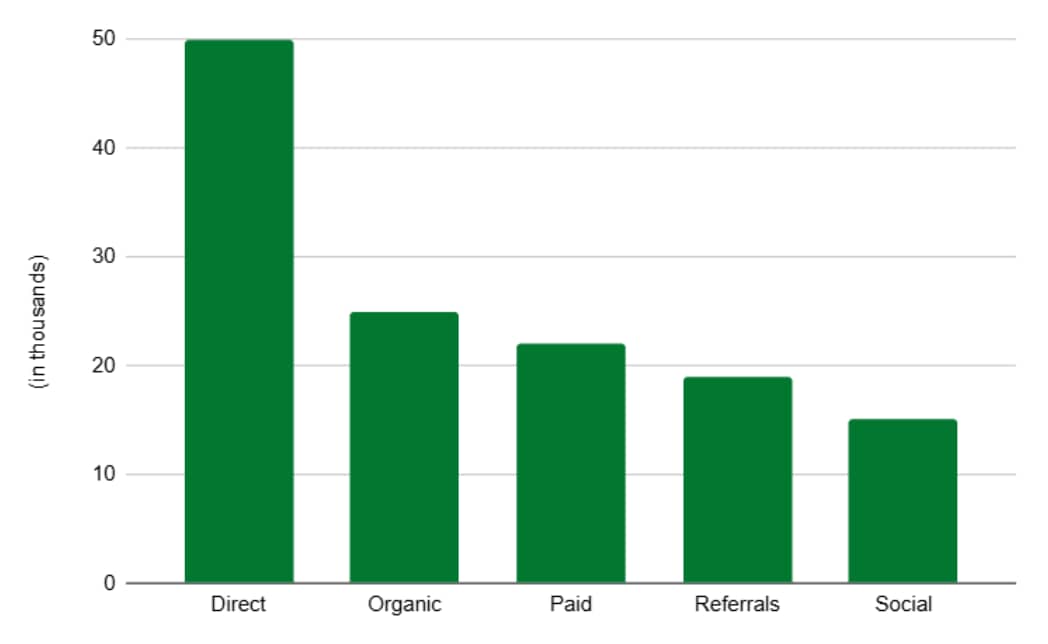
Start by gathering data on metrics like website traffic, conversion rates, customer engagement and return on investment.
Use tools like GA4, ad dashboards and CRM tools like Pipedrive to track how leads move through each touchpoint and contribute to the sales pipeline.
Social media marketing, for example, might drive strong awareness but low direct conversions. Email marketing may outperform other channels when targeting existing leads. These insights help you fine-tune your channel mix and reallocate your marketing budget where it counts.
Did you know? Pipedrive’s deal management features can help you track how each source contributes to closed deals and lead velocity, making it easier to optimize your marketing efforts based on real outcomes.
Competitive and market research
A strong marketing audit includes a detailed look at your competitors and overall market conditions. Competitive research helps you understand how your brand is positioned, what your target audience expects and where your marketing strategy can stand out.
Tools like SimilarWeb and Semrush can help you gather data on website traffic, keywords and paid search visibility.
Here’s what a competitive audit looks like in Semrush:
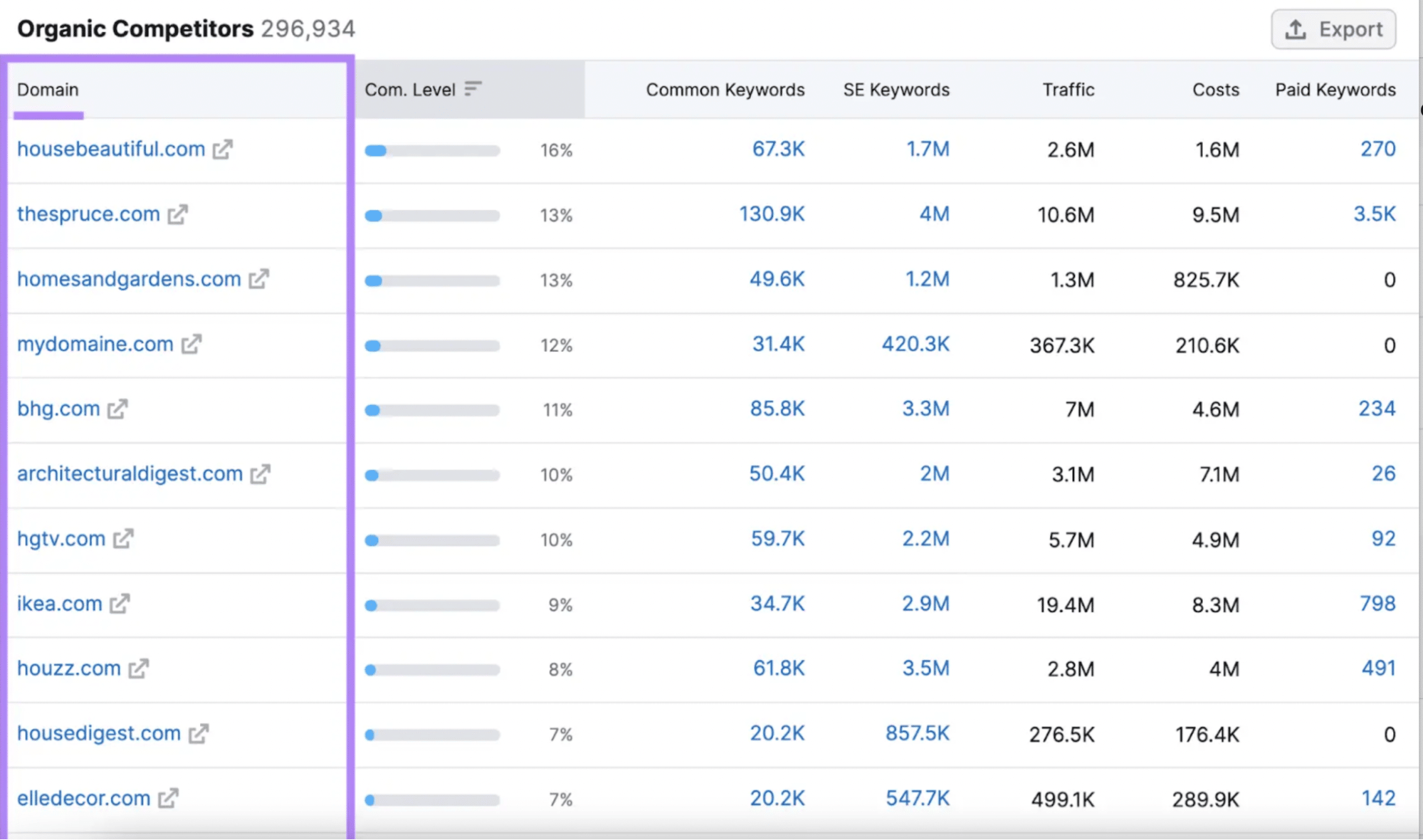
.
Tip. Look beyond just who’s ranking. Analyze why competitors are performing well. Review their messaging, CTAs and landing page experience. This analysis can reveal gaps in your marketing and spark ideas for improving engagement, conversion and positioning.
Brand and messaging consistency
Consistency in your brand and messaging builds trust and recognition with your target audience. A marketing audit should assess whether your voice, tone and visuals are aligned across all marketing channels.
Start by doing a quick content marketing audit and examining areas such as email campaigns, landing pages and social media platforms.
Look for variations in tone, outdated messaging or mismatched visuals that could confuse or disengage your audience.
Ask yourself:
Does our messaging reflect our current marketing goals and customer personas?
Are we using a consistent brand voice across all content formats?
Do our visual elements match across platforms and campaigns?
You should also compare messaging against competitor brand positioning to spot missed angles or ways to stand out more clearly.
Even small inconsistencies in branding can impact customer engagement, especially across high-traffic channels like social media marketing and email. This part of the audit ensures that every touchpoint reinforces a unified brand experience.
Martech and workflow evaluation
Your marketing technology stack plays an important role in how smoothly your team can operate.
According to MarTech’s 2025 State of Your Stack Survey, 62% of respondents use more martech tools than they did two years ago.
However, tools can stack up quickly, or you might end up with some that do the same thing. To prevent overlap, regularly audit your stack for redundancy and assess whether each tool adds unique value or can be consolidated.
Start by listing the tools you use across digital marketing, content creation, workflow automation, email marketing and analytics.
Then assess how well they integrate, how often they’re used and whether they deliver value.
Look for gaps that could affect marketing performance. You may find that some tools are outdated, unused or overlapping in function.
The goal is to streamline your marketing function so your team can focus more on creative strategy and less on admin. A clean, efficient stack helps improve execution and enables quicker, data-driven decisions.
How do you conduct a digital marketing audit?
Running digital marketing audit services doesn’t have to be overwhelming. With a clear action plan and the right tools, you can quickly identify what’s working, what’s not and where to focus next.
1. Set audit objectives and define KPIs
Start your audit by clarifying the “why”. Are you trying to improve ROI, boost lead generation or evaluate a recent campaign?
For example, let’s say you’re a B2B SaaS company that recently launched a new product but isn’t seeing the expected growth in qualified leads.
You want to audit your landing pages and paid ad campaigns to identify why conversions are low and how to improve your customer acquisition cost (CAC).
Setting focused objectives helps keep the audit manageable and aligned with your business goals.
Define a small set of KPIs that reflect those objectives. These might include:
Conversion rates from paid search or landing pages
Leads generated by channel or campaign
Customer acquisition cost
Return on investment across digital marketing activities
Pipedrive offers powerful KPI tracking features for small and medium-sized businesses. You can track all the metrics you need through dashboards and custom reports.
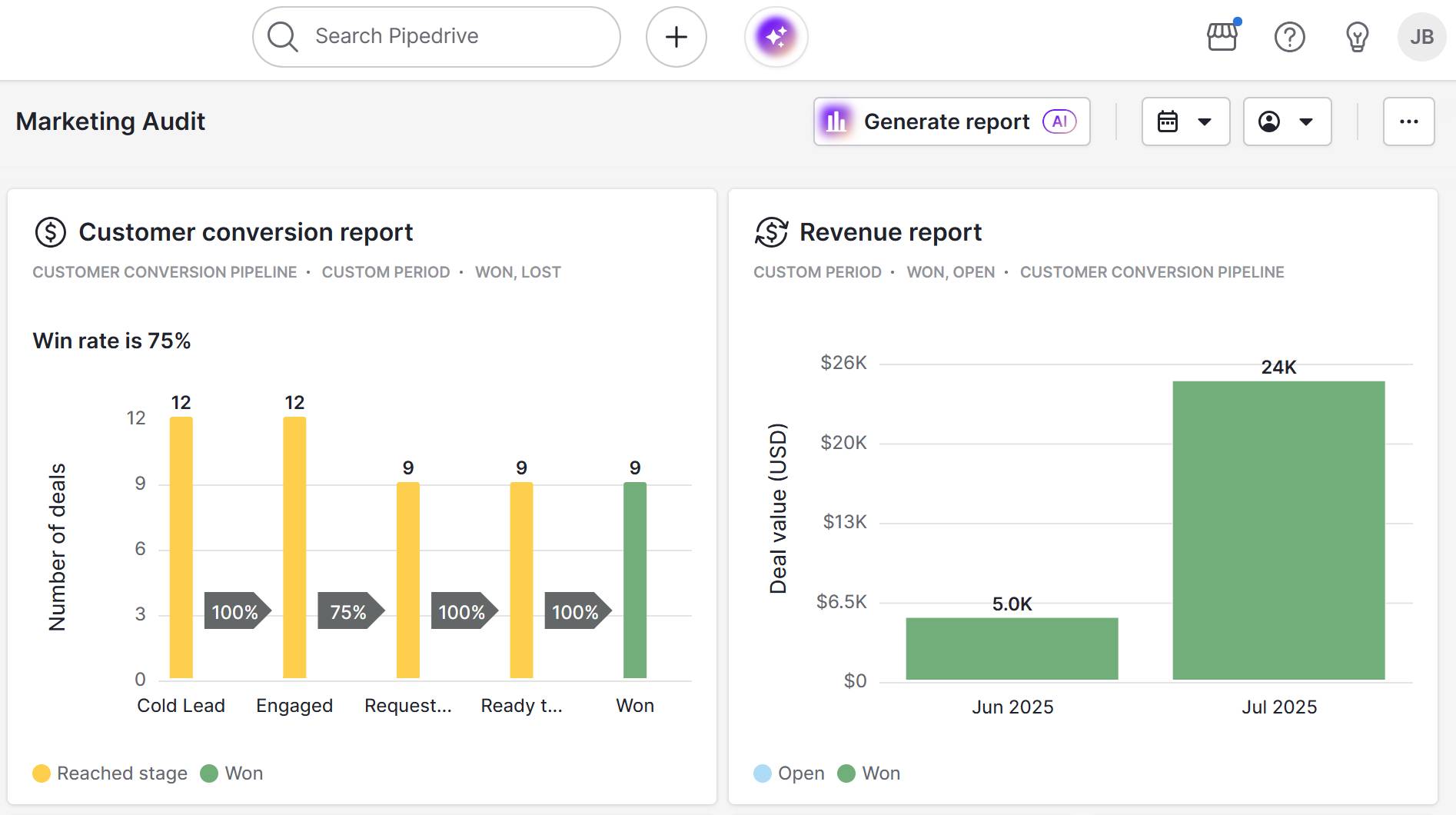
With a clear view of marketing and sales performance, you can focus on what drives real results.
2. Decide what areas you’ll audit
Once your objectives are set, map out the scope of your audit.
Focus on the areas most relevant to your goals. To improve lead quality, prioritize SEO, landing pages and lead source tracking. To reduce spend, audit paid channels and campaign ROI.
Let’s continue our B2B SaaS example. Since the main concern is low lead volume and poor conversion on your new product landing pages, your audit should focus on:
Paid channels (e.g., Google Ads, LinkedIn Ads)
Landing page performance and form completion rates
Messaging consistency across ads and landing pages
Customer acquisition cost benchmarks
Defining your audit areas early helps you stay focused and avoid chasing irrelevant data.
3. Gather your data
With your audit areas defined, collect data showing how each one performs. Pull reports from key platforms like GA4, ad dashboards, email software and your CRM.
In our SaaS example, key data would include:
Landing page views, bounce rates and form submissions from GA4
Cost-per-click, impressions and conversion data from Google Ads and LinkedIn Ads
Lead source tracking and deal progress data from your CRM
Customer acquisition cost and lead quality segmented by campaign
Use consistent date ranges and segment by channel, campaign and audience. Clean, organized data is essential for spotting gaps and making informed decisions.
4. Evaluate and summarize insights
With your data collected, it’s time to make sense of the story it tells. Instead of scanning numbers in isolation, look for patterns: what’s gaining traction, what’s stalling and where your marketing efforts are falling short.
For example, you might find that Google Ads drive high landing page traffic but have a low conversion rate. Meanwhile, LinkedIn Ads generate fewer visits but convert at a much higher rate.
Spotting these trends helps you understand what’s moving the needle and what’s draining your marketing or sales budget.
Group your insights by objective or channel to keep them clear and easy to act on.
Highlight any surprises or outliers that deserve a closer look. Use visuals like graphs or tables to back up your conclusions and create a snapshot that your team can quickly digest.
At this stage, focus on turning patterns into practical takeaways – i.e., specific lessons or actions your team can implement to improve targeting, channel performance or messaging consistency.
5. Make strategic recommendations
Wrap up your audit by turning your findings into clear, actionable next steps. Prioritize changes that will have the biggest impact on your marketing performance and align with your business goals.
In our SaaS example, your recommendations might include:
Rewriting the landing page headline to better reflect the ad offer
Removing friction from the sign-up form by reducing fields
Shifting budget from underperforming Google Ads to higher-converting LinkedIn campaigns
Setting up lead scoring in Pipedrive to qualify inbound leads faster
You could package your recommendations as a short deck or dashboard view, making it easy for stakeholders to approve and act on them quickly.
Each recommendation should link directly to a KPI or objective to ensure your audit moves from analysis to meaningful action.
Essential tools to make your marketing audit easier
You need the right tools to conduct an effective marketing audit.
Below are essential platforms that help you evaluate performance, uncover insights and take action. Each one supports a different part of the audit process.
Pipedrive
Pipedrive is a sales-focused CRM that gives marketing and sales teams full visibility into how campaign activity translates into pipeline movement.
Pipedrive’s CRM Analytics feature gives users an at-a-glance view of deal progress and activity metrics.
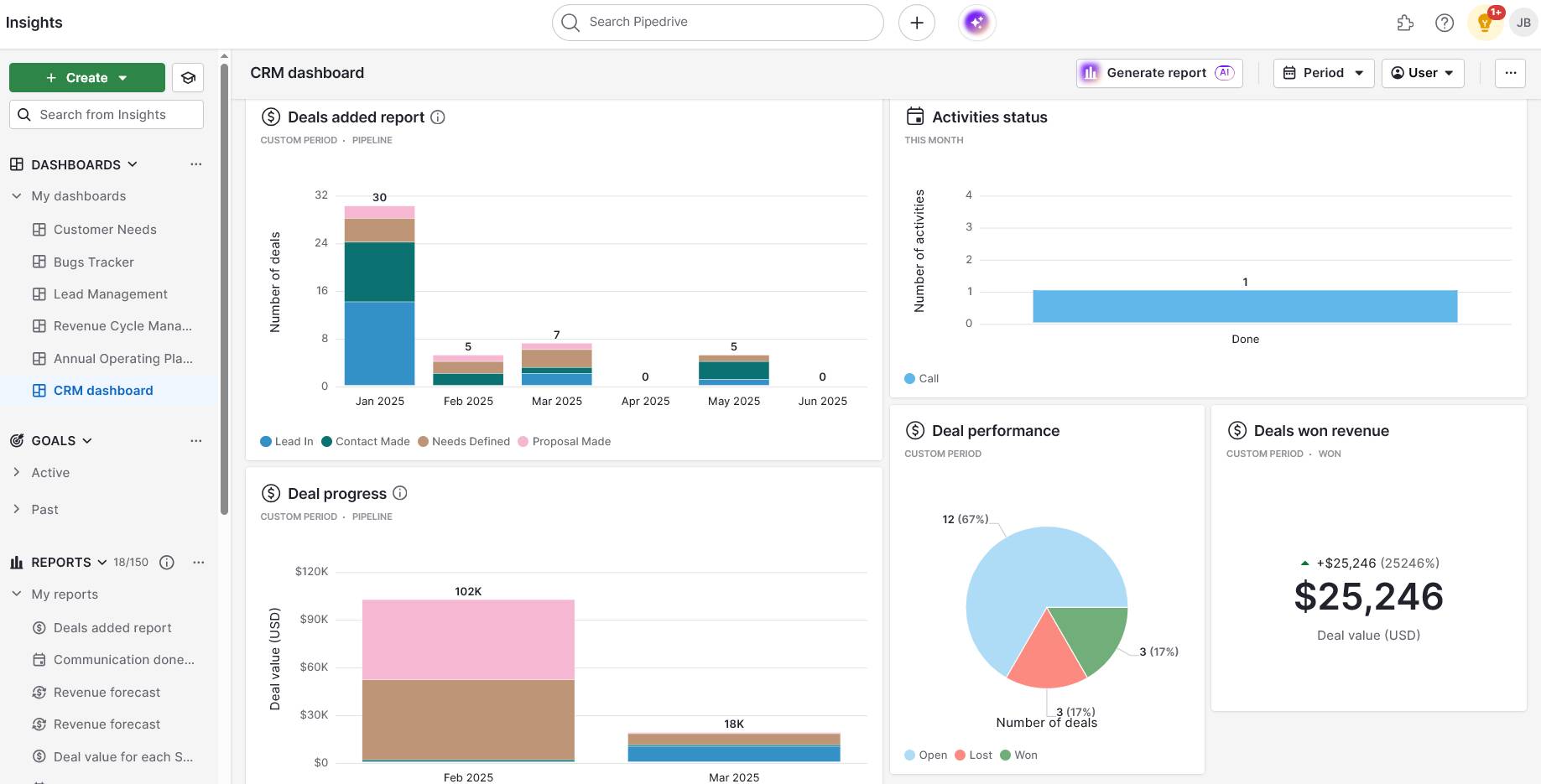
For example, users can track how many qualified leads from a specific email campaign move into different deal stages or assess campaign success by comparing win rates across segments.
Built-in lead scoring further enhances targeting by automatically prioritizing leads based on customizable criteria, so teams can focus their efforts where they’re most likely to convert.
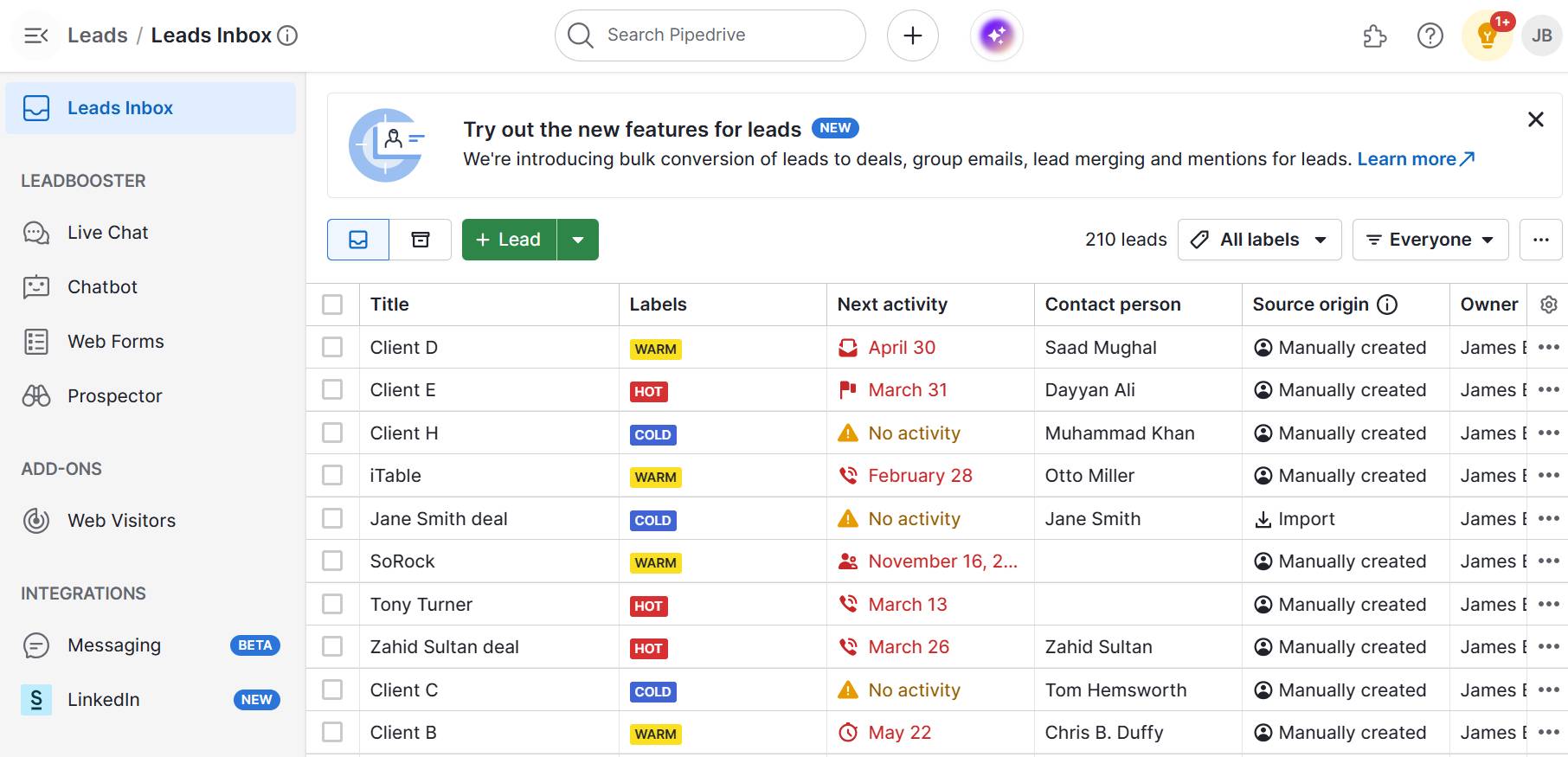
Pipedrive also has many AI-powered capabilities (such as its AI-powered Sales Assistant) that offer real-time guidance, surfacing actionable insights to boost productivity and optimize outcomes.
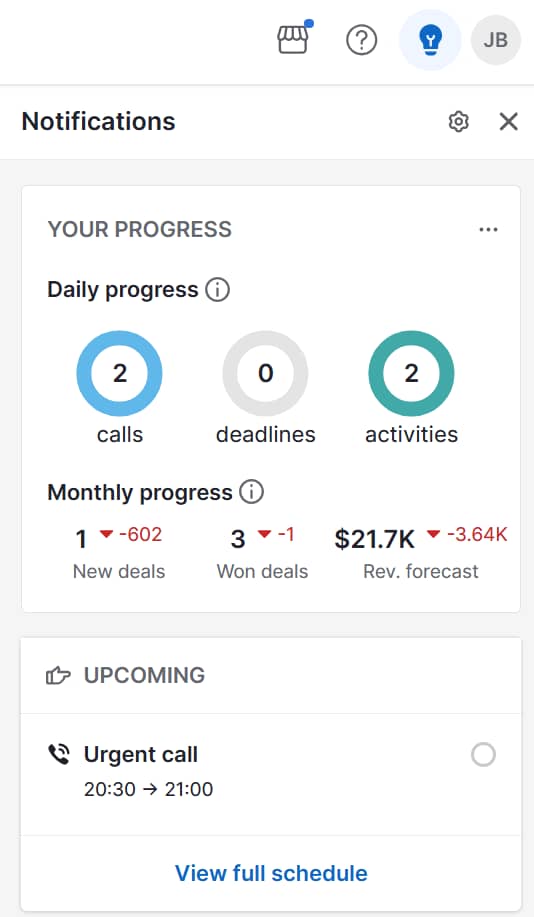
Best for: Linking marketing efforts to pipeline results, analyzing lead quality and prioritizing campaigns that drive revenue.
Google Analytics 4 (GA4)
GA4 is your go-to platform for understanding how users engage with your website and landing pages. It tracks key metrics like traffic sources, bounce rates, user journeys and goal completions – all in real time.
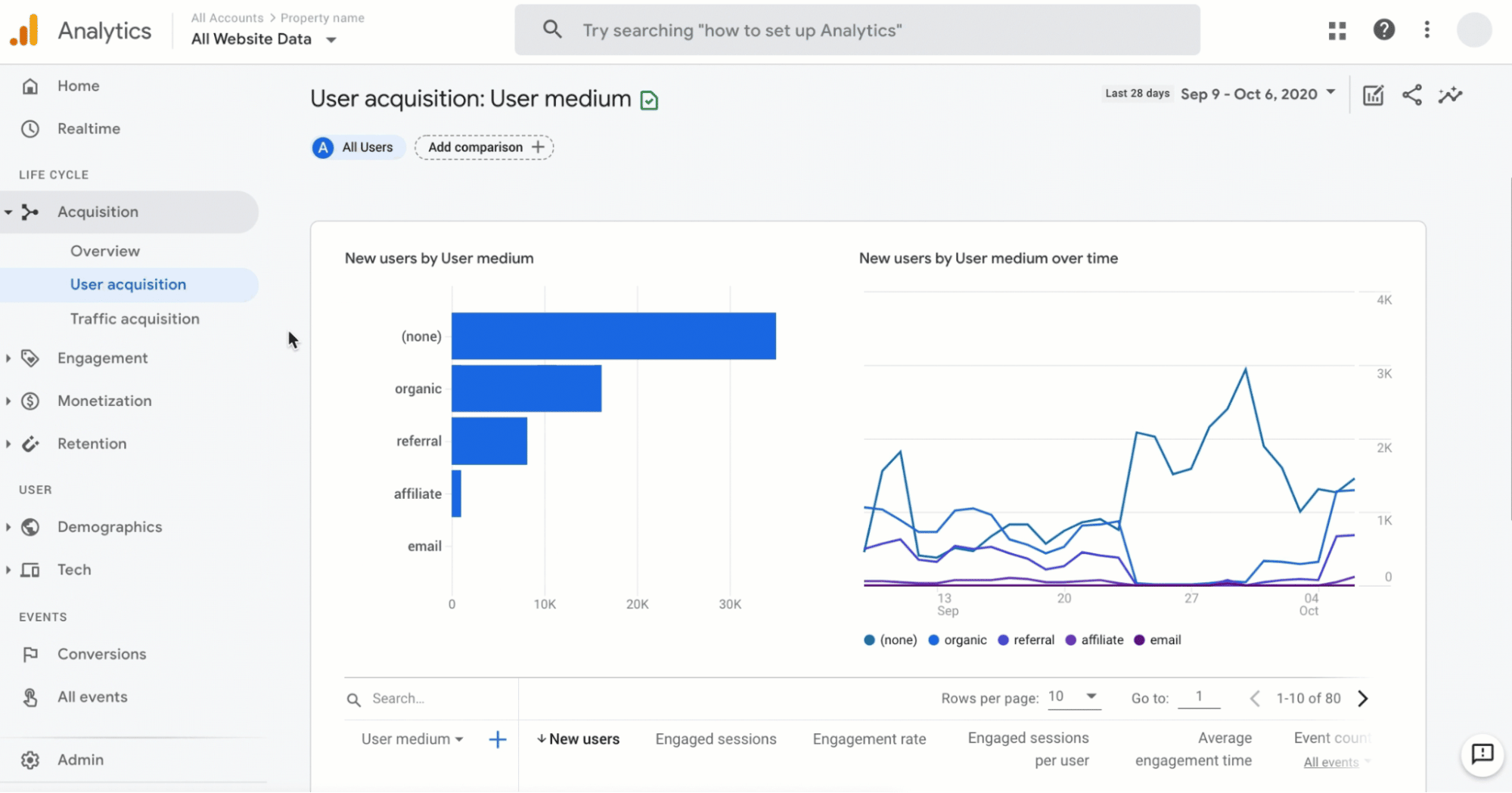
GA4 also allows event-based tracking to see how specific actions (like clicks or downloads) contribute to conversions and marketing performance.
Best for: Analyzing website traffic and user behavior and identifying drop-off points in your conversion funnel.
SEO tools
SEO tools like Semrush and Ahrefs give you a clear view of how your content performs in search. They show keyword rankings, backlinks, site health and historical trends, making it easier to spot SEO gaps or opportunities.
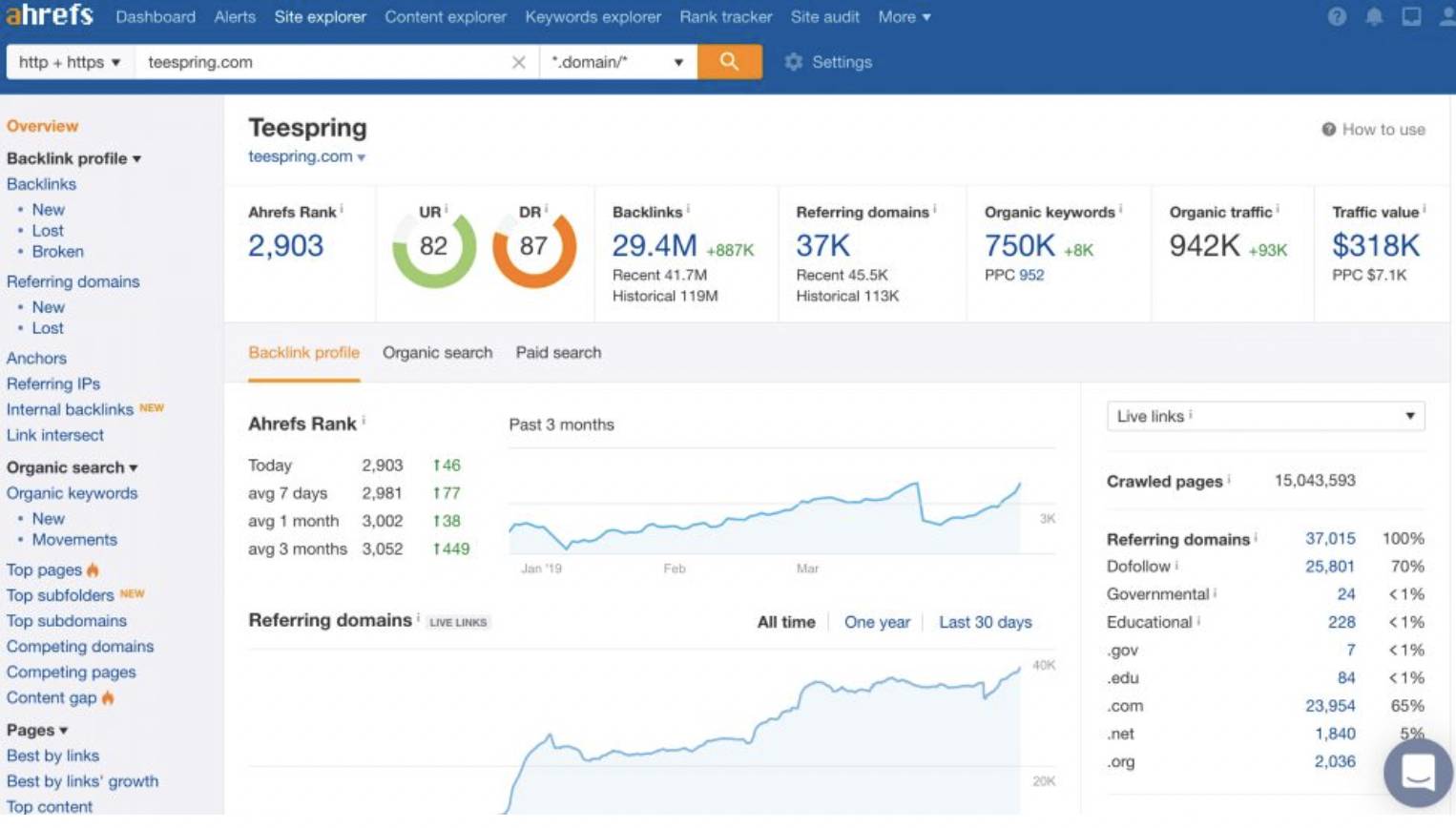
These platforms also let you track competitors’ rankings and find high-value keywords to target in future campaigns.
Best for: Auditing search visibility, finding content gaps and monitoring technical SEO performance.
Competitor analysis tools
Competitor analysis tools like SimilarWeb provide insight into your competitors’ digital presence, including traffic volume, traffic sources and audience behavior.
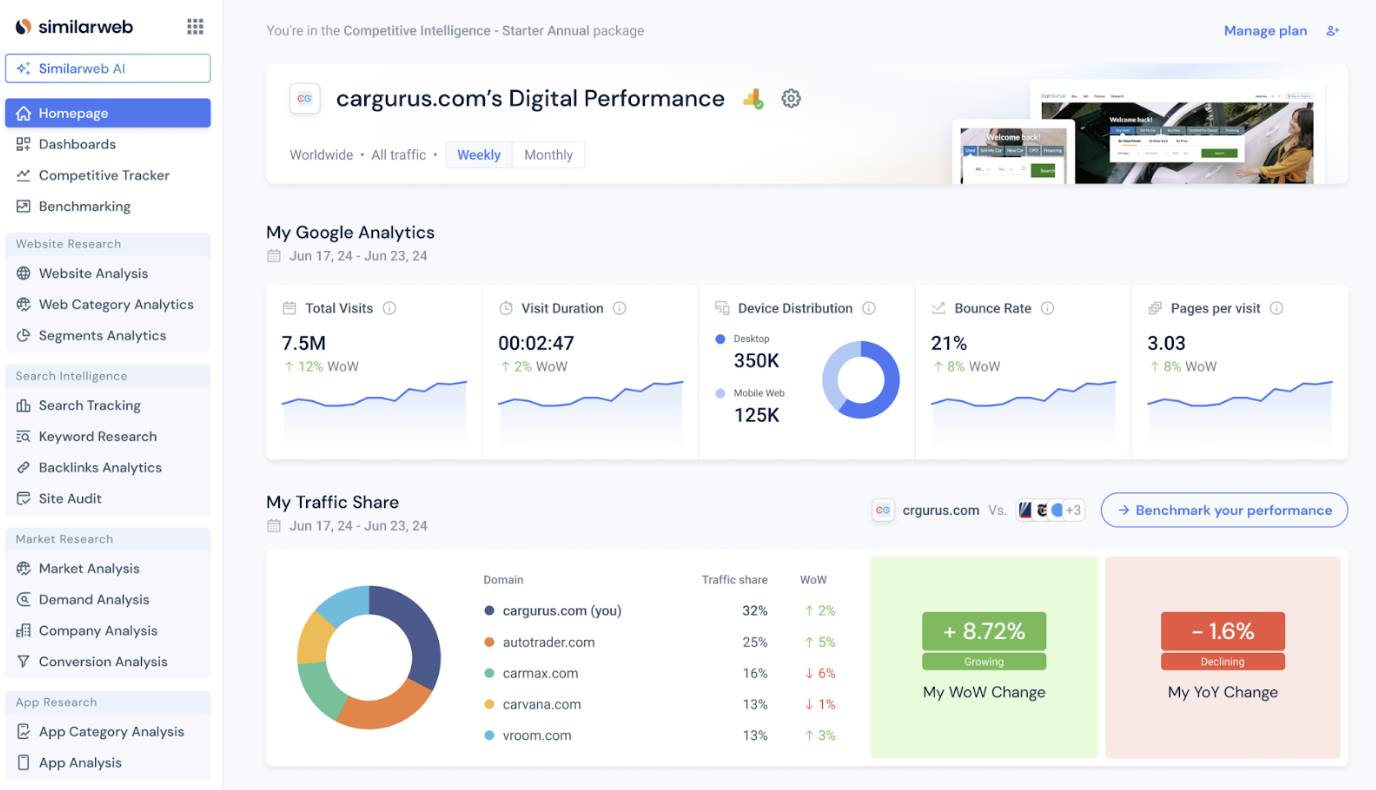
You can benchmark your performance, discover new marketing channels and see what’s driving traffic to similar businesses. This tool helps bring an outside perspective to your marketing audit.
Best for: Benchmarking digital performance, identifying competitor strategies and uncovering new channel opportunities.
Ad platforms
Ad platforms, like Google Ads, give you access to detailed performance data for your paid campaigns. You can review impressions, click-through rates, cost per lead and audience breakdowns.
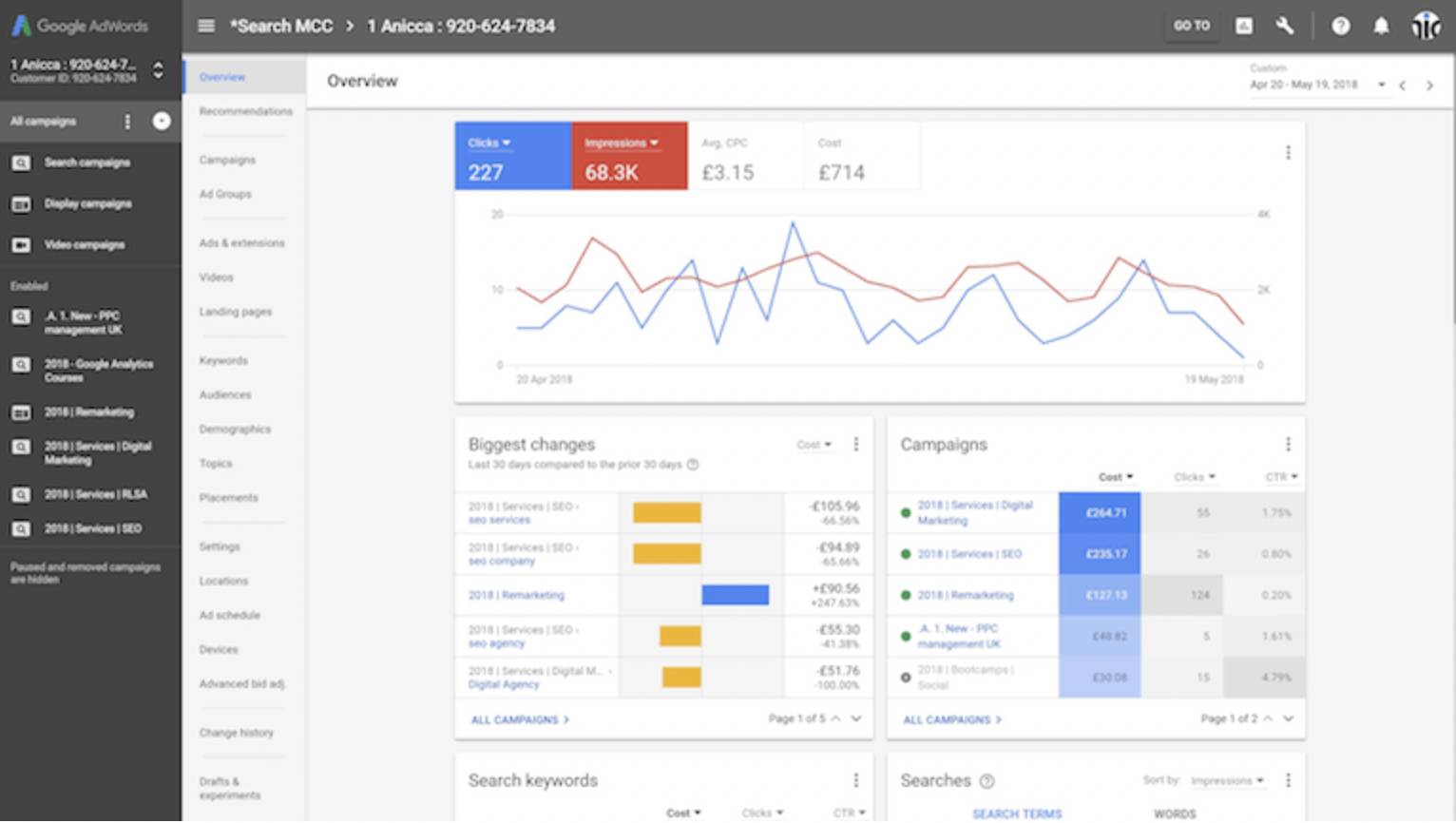
Paid media data makes it easier to understand which campaigns drive real engagement and which are wasting budget.
Most platforms also offer attribution insights, helping you connect ad spend to downstream actions like form submissions or purchases.
Best for: Evaluating paid channel performance, optimizing budget allocation and refining audience targeting.
Questions to guide your marketing audit
Even with the right tools and data, it can be hard to know where to focus.
The following questions help you examine performance more deeply, align marketing efforts with business goals and uncover high-impact areas for improvement.
Use them as a checklist to guide discussions, structure reporting or shape next steps after your audit.
Question | Description |
How does your brand’s share of voice (SOV) compare to competitors? | This metric reveals your visibility in the market and whether your content and campaigns are breaking through. |
How well are you ranking for high-intent keywords in organic search? | Keyword rankings reflect the strength of your SEO efforts and how effectively you’re attracting the right audience. |
What percentage of website visitors convert into leads or customers? | Website conversion rates show how effective your landing pages, forms and calls to action are at driving action. |
Which marketing channels deliver the highest return on investment? | Identifying top-performing channels helps you prioritize spend and optimize the mix of your marketing activities. |
How much revenue can be attributed to marketing campaigns? | Tracking pipeline marketing contribution ensures your team is focused on initiatives that support measurable business growth. |
These questions help structure your marketing audit around real outcomes, not just surface-level metrics.
Final thoughts
A marketing audit helps you pause and refocus. Audits allow you to fine-tune what’s working and cut what’s not, so every marketing activity supports your goals.
Pipedrive makes it easy to connect your marketing data to real outcomes. Track lead sources, measure pipeline contribution and see which campaigns drive revenue, all in one place.
Start your free 14-day trial of Pipedrive today and turn insights into action.








